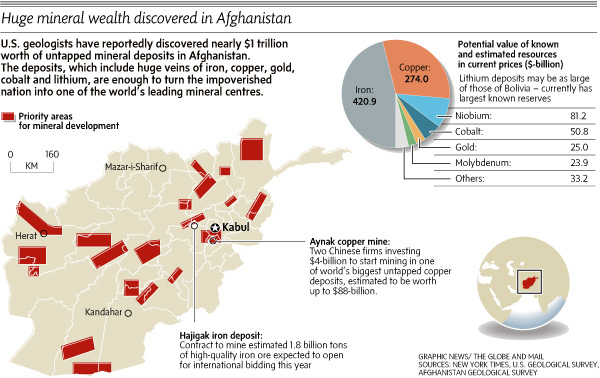Billions of reasons why Obomber wants troops left in Afghanistan…
+++
The Pentagon’s Map of Afghanistan: An Eldorado of Mineral Wealth and Natural Resources
By Nikolai Malishevski
Global Research, March 14, 2014
Strategic Culture Foundation 8 August 2012
Region: Asia
Theme: Global Economy
In-depth Report: AFGHANISTAN
[iframe width="468" height="60" frameborder="0" marginwidth="0" marginheight="0" vspace="0" hspace="0" allowtransparency="true" scrolling="no" id="aswift_0" name="aswift_0" style="margin-top: 0px; margin-right: 0px; margin-bottom: 0px; margin-left: 0px; padding-top: 0px; padding-right: 0px; padding-bottom: 0px; padding-left: 0px; border-top-width: 0px; border-right-width: 0px; border-bottom-width: 0px; border-left-width: 0px; border-style: initial; border-color: initial; font-size: 12px; font: inherit; vertical-align: baseline; left: 0px; position: absolute; top: 0px; "][/iframe]

Curious information surfaced in the media [2012] – based on space reconnaissance, the US Department of Defense put together a map of Afghanistan showing in detail the country’s mineral riches which, as it transpired, may be quite impressive.
The fact that Afghanistan sits on lucrative natural resources was recognized indirectly back in 2010 when the Afghan ministry of mines rolled out a $1b (!) estimate of what the country might have, and The New York Times quoted a source in the US Administration as saying that Afghanistan’s list of reserves included copper, gold, cobalt, and even lithium on which the present-day industry is heavily dependent. A Pentagon memo actually described Afghanistan’s potential lithium holdings as big enough to make it the “Saudi Arabia of lithium”. Somehow, the news flew below the radars of most watchers worldwide.

It must be taken into account in the context that the areas used for poppy cropping in Afghanistan expanded by a factor of magnitude since the Western coalition invaded the country with an anti-terrorist mission and brought down the Taliban rule. At the moment, millions of Afghans are involved in poppy farming and processing or in heroin trafficking. A year after the advent of the Western coalition, Afghanistan entered the world stage as a heroin monopoly, outputting over 60% of the global supply. It is an open secret that the farmlands given to poppy in Afghanistan far exceed in proportions the cocaine plantations in Columbia, Peru, and Bolivia combined. The US-British explanation is that farmers in Afghanistan – an underdeveloped country supposedly having no natural resources – have to cultivate drugs for survival.
Citing the above claims, in the 2000ies Washington dropped Afghanistan from the narcotics blacklist and lifted the pertinent sanctions. The US President said the step was in the US national interests, while in no time the Afghan “farmers” confronted the neighboring countries, Russia in particular, with the nightmare of a permanent drug Jihad.
Actually, Soviet scientists discovered decades ago that the soils of Afghanistan contained ample mineral resources. Among those, for example, are precious and semiprecious stones: samples of the Sar-e-Sang District Lazurite, whose quality craftsmen praise as exemplary, were found even in Pharaohs’ tombs and during the Troy excavations. The emerald deposit unsealed back in the 1970ies in the Panjshir Province ranks with the world’s largest, with gems comparable in quality to the acclaimed ones mined in Columbia. Also long ago, the Soviets were aware of the existence of Uranium reserves in Afghanistan – in Gen. A. Lyakhovsky’s account presented in his Tragedy and Honor in Afghanistan, the threat that the Uranium would be grabbed by Pakistan and Iran to build nuclear weapons was cited as an argument in favor of the future Soviet invasion at a pivotal December 8, 1979 meeting personally chaired by L.I. Brezhnev.
The Soviet explorations which went on in Afghanistan till the late 1980ies showed that Afghanistan was extremely rich in various types of ores, with the resources hitherto untapped as the country had never been colonized. The Aynak copper deposit is the biggest in Eurasia, and the Hadjigek iron ore in the proximity of Kabul is believed to be the the top one in South Asia. Pegmatite reserves usable as sources of rubies, Beryl, and seldom-found gems – kunzite and hiddenite – are located east of Kabul. Pegmatite fields can, furthermore, serve to derive Beryllium (estimatedly, the corresponding reserves are the biggest known up to date with a total of over 73,500 tons), Lithium, Tantalum, and Niobium, the substances steady demand for which is pressed by the high tech sector along with the nuclear and aerospace industries.
The Pentagon, therefore, confirmed the old Soviet findings about the reserves of precious metals, ores, sulfur, Lazurite, Baryte, Celestine, etc. in Afghanistan, and actually went further, scrupulously compiling a map of the deposits. The story deserves attention, considering that, contrary to the widespread notion, the war the Afghan mujahiddeen used to wage against the Soviets did not end when the Soviet forces were withdrawn from Afghanistan. In the 2000ies, the war recurred in the form of a drug offensive which cost Russia more lives than the botched Afghan military campaign. In that now fairly distant era, the Soviet death toll reached around 15,000 overall, while these days Afghan drugs kill up to 20,000 people in Russia annually, crippling far more. Most of the victims, it must be noted, are young people. It is absolute cynicism to justify the above with allegations that Afghanistan’s poverty leaves its farmers with no choice but to cultivate drugs. |




